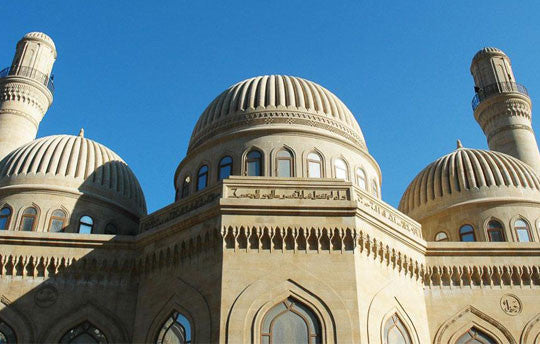Your Cart is Empty

Bordered by Russia, Georgia, Armenia, Iran and the Caspian Sea, Azerbaijan has a population of eight million. Since independence, Azerbaijan has fared better economically than Georgia and Armenia, although there is still tension with Armenia over the region of Nagorno-Karabakh.
Azerbaijan was part of the Persian Empire until it was conquered by Russia in 1801, and the traditional instruments are the same as those found in Persian music: the tar (long-necked lute with a skin-covered belly), kemençe (spike fiddle) and daf (frame drum). In Azerbaijan, three cultures meet – Turkish, Persian and Russian. Now, thanks to the oil, American-style capitalism has also moved in.
There is a specific Azeri style called meyxana (wine-singing), performed by wedding singers known as meyxanaçi. The music is sharp and satirical and has now become the most significant musical genre in Azerbaijan. Accompanied by keyboards, bass guitar and some traditional instruments like balaban (duduk) and daf, it can be seen as a continuation of the old asiq tradition.
In Soviet times meyxana was an unofficial “underground” music, sung in either Azeri or Russian. One of the most notorious songs of the 1980s was 'Zhiguli' (the name of the Soviet Fiat), by the singer Agasalim Salimov. Nowadays, meyxana is appealing to a cross- section of Azeri society and reflects contemporary issues at a local level. A big hit in 2005 was “Dostum” by Vüqar, a singer from the Azeri capital, Baku. The instrumental tune 'Vaqzali' accompanies the entrance of the bride, and the bridegroom’s melody 'Bey Tarifi' is performed at the end of the wedding. Wedding dances originating in the rural western parts of the country, such as the women’s xalay and men’s yalli, have also found their way into the urban repertoire.
The word a?iq derives from Arabic or Persian and means “lover”. In the eighteenth century bards like the Armenian Sayat Nova in the cosmopolitan Georgian capital Tiflis (Tbilisi) commonly sang in Armenian, Turkish and Persian. The word comes from Sufism and refers to the a?iq’s love of God. The a?iqs performed religious and love poems, moralistic tales and long lyric or epic ballads, modified and adapted to suit the audience. Great Azeri bards include Dede Korkut, Shah Ismail, Asiq Qurbani and Asiq Alaskar.
The a?iq tradition survives amongst the Azeris in both Iran and Azerbaijan, with singers accompanying themselves on the long-necked saz, or çogur. Other instruments associated with the a?iqs are the balaban and daf. Top asiq performers include Alim Qasimov – who is also the best-known mugham singer – and Edalat Nasibov, who renders epic a?iq pieces in instrumental form on the saz, accompanied by dramatic body movements. Emran Heydari, from Iran, is another significant name.
While the a?iq’s music is rooted in popular culture, mugham is urban art music. There are twelve main mugham modes, including rast, shur, segah and chargah. Simplistically, rast can be seen as happy, while shur is perceived as sad. The suite usually begins with an improvisatory instrumental prelude and then alternates sung poetry and instrumental passages. Within the tonal constraints, it is up to the singer to choose the poems and instrumental passages that make up the mugham. The instrumental ensemble is usually a trio of daf, tar and kemençe. The daf is usually played by the singer, with the tar and kemençe often echoing or anticipating the vocal line.
The king of mugham singers, Alim Qasimov, is celebrated for the emotional power of his voice and his expressive vocal ornamentation, an important part of mugham. He’s also a master of the tahrir technique in which he adopts a high head voice, almost like yodelling. He has performed for many years with the brothers Malik and Elsham Mansurov on tar and kemençe. Other notable mugham performers include Zahid Guliyev, Djanali Akberov and the female singers Sakine Ismaïlova, Sevintch Sariyeva and Aygun Bayler, who also performs folk and jazz mugham. The number of women performing mugham here (as opposed to in Iran) is one of the more positive results of Soviet Russian influence.
Russian musical influence in Azerbaijan goes back to the nineteenth century and can be seen in the work of Uzeyir Hajibeyov (1885–1948). He composed Leyli & Majnun, a mugham opera described as the first opera of the Muslim East, frequently referred to in mugham poetry. His opera Koroglu is based on a famous asiq epic. Azerbaijan Mugham, a large orchestral work by Fikrat Amirov (1918–82), was recorded by the eminent conductor Leopold Stokowski, while Haji Khanmammadov (1918–2005) wrote five concertos for tar and orchestra. Mugham music also influenced Azeri jazz, and the Baku Jazz Festival has a growing reputation. The pianist Vagif Mustafa-Zadeh began playing what he called “Mugham Jazz” in the 1960s, improvising in piano versions of Azeri modes and rhythms. Mustafa-Zadeh died tragically young in 1979, aged just 39, but his daughter Aziza Mustafa-Zadeh, a singer and pianist has followed in his footsteps, bringing a distinctly Azeri feel to her solo playing.
Since independence, pop music in Azerbaijan has been very open to outside influences, with plenty of rap singers. However, some bands including Bakustik, Bery Bax and Rast have combined Western keyboards, guitars and drums with local instruments like the tar, balaban and garmon (accordion). Predictably, there are strong influences on Azeri popular music from Russian estrada and Turkish pop and arabesk. Singers like Aygün Kazimova and Brilliant Dadasova could be compared to Turkey’s Sezen Aksu in the way they combine Azeri traditional music with modern sounds. The war over Nagorno-Karabakh has led to a rise in the the increasing popularity of mugham. In Baku there are now over thirty state-supported schools where, as part of the curriculum, students are taught to sing and play mugham. This is impressive since mugham is, after all, a difficult and sophisticated genre.